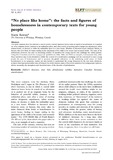‘‘No place like home’’: the facts and figures of homelessness in contemporary texts for young people
Metadata
Afficher la notice complèteAuthor
Reimer, Mavis
Date
2013Citation
Reimer, Mavis. “’No place like home’: The Facts and Figures of Homelessness in Contemporary Texts for Young People.” Barnelitteraert forskningstidsskrift (Nordic Journal of ChildLit Aesthetics) 4 (2013): n, pag. DOI: 10.14811/clr.v36i0.103.
Abstract
The most common story for children is one in which a central character leaves home in search of an adventure or is pushed out of an originary home, journeys to an unfamiliar place, and, after a series of exciting and/or dangerous experiences, either returns home, or chooses to claim the unfamiliar space as a new home. Whether as historical novel, domestic fiction, or fantasy, this story finds its happy ending in the agreement of the child to be secure (and secured) inside. The turn of the millennium, however, has seen an increasing number of narratives for young readers that challenge the earlier pattern.
Using three Canadian novels for young people (published in 2004, 2006, and 2007) as examples, I demonstrate that, while these narratives may locate themselves within the context of a social-justice pedagogy and are concerned to teach young people the facts of homelessness and to promote thoughtful reflections on the underlying social causes of which homelessness is the symptom, readers are also invited to understand the young characters in the text more abstractly, as figures that represent possible ways of being in the world. Indeed, many of the recent narratives for young people replicate, almost uncannily, the metaphors and rhetorical turns of the theorists of globalization.

